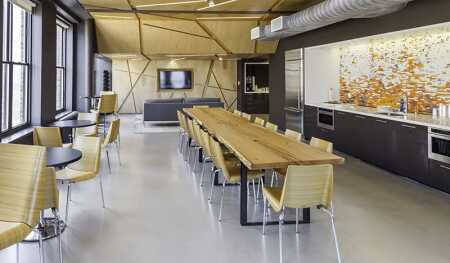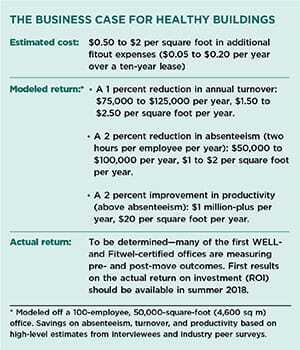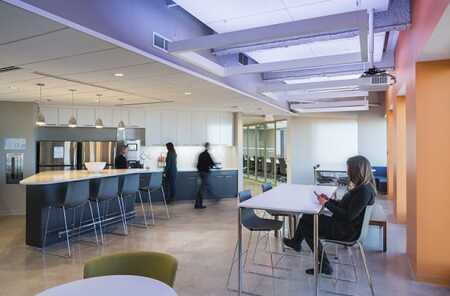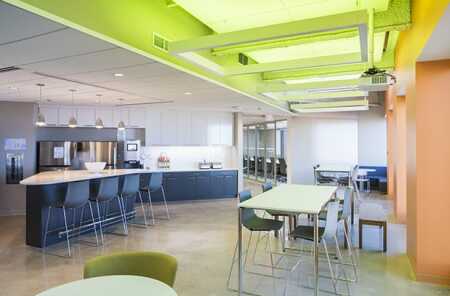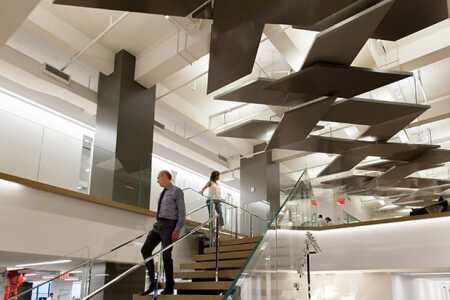After years of development, marketing, and promotion, the first WELL-certified projects have hit the market. Early this year, the first WELL office projects opened in New York City, Boston, and Vancouver, joining early adopters in Toronto, San Francisco, and Los Angeles in the growing real estate market for healthy-certified buildings.
With a handful of WELL-certified projects now in operation and hundreds in the certification pipeline, real estate owners and developers are starting to take a hard look at the business case for healthy building certification. From these first few projects, it is clear that this business case is still developing, but it will look a lot different than the one that has driven the green building certification movement to date.
How Much Does Health Certification Cost?
For the first generation of WELL-certified office projects, the hard and soft costs varied considerably. A few early adopters completed their WELL-certified fitouts for less than $1 per square foot ($10.76 per sq m) in additional costs. For the rest, the cost of WELL ranged from $1 to $4 per square foot ($10.76 to $43.04 per sq m). The biggest expenses for most tenant fitout projects were in acoustics (reducing noise in an open office), enhanced HVAC filtration and zone control (cleaner indoor air), and increased employee access to nourishment (replacing vending machines with cafés and kitchens, stocked with healthy snacks).
What does a tenant get for its investment of 50 cents to $4 per square foot ($5.38 to $43.04 per sq m)? The WELL standard focuses on seven key elements of a healthy building—air, water, nourishment, light, fitness, comfort, and mind.
For Structure Tone employees, their new New York office provided better nourishment (a health-focused café with natural light) and better light (including daylight, indirect light, and light that supported their natural circadian rhythms). Subsidies for bike-share program CitiBike and discounted fitness facility memberships checked the “fitness” component of WELL, and new sit/stand desks and tables helped employees achieve better comfort, while better acoustical design helped improve productivity and concentration. Increased ventilation and better zone management helped keep employees comfortable in all seasons.
Outside of cost, one of the biggest challenges cited by early adopters was getting used to a new certification process and timeline—in general, WELL certification took longer than Leadership in Energy and Environmental Design (LEED) certification for many early projects because of the required letters of assurance and post-project on-site monitoring and evaluation. That being said, one of the early adopters said they found the WELL experience faster than LEED—by having fewer written documentation requirements and more active engagement with their WELL certifier, they were able to reduce the amount of time they would have spent documenting and defending credits toward LEED certification.
Value Proposition: Employee Health, Productivity, and Satisfaction
For the first-generation WELL projects, the goal of WELL certification was to help employees be healthier, happier, and more productive at work. According to a study published in Environmental Health Perspectives, offices with good ventilation and superior air quality can improve cognitive function as much as 101 percent. Other recent studies have found that improving thermal comfort, access to daylight, and even a “biophilic” workplace can significantly increase worker satisfaction, reduce absenteeism, and contribute to increased productivity. For most office tenants, a 1 percent improvement in productivity is worth far more to their bottom line than $1 per square foot ($10.76 per sq m) per year.
Taking a more cynical approach, if a healthy building can reduce turnover by 1 percent per year, this will save most professional companies $150,000 to $200,000 or more in finding, hiring, and training new employees.
At Arup, the driver for pursuing WELL certification at its Boston office came down to three key statistics—“90 percent of operating expenses go to staff salaries and benefits, 90 percent of time is spent indoors, and 90 percent of people say the work environment adversely affects their attitude toward their company,” notes Mallory Taub, an Arup sustainability consultant who was the WELL Accredited Professional (AP) on the project. “Given these drivers, it was a logical decision to invest in an office environment that could help our employees be happier and healthier.”
Arup estimated that the additional cost to pursue WELL certification added a 0.5 percent cost premium to its office fitout. If the WELL office improved productivity 0.5 percent over the lifetime of the lease, Arup estimated that the project would be worth the cost.
Rob Leon, senior vice president at Structure Tone, had a more personal example of increased productivity from his firm’s WELL project. “I used to walk to the deli every afternoon for a healthy snack. With the new café, I am saving 15 minutes a day, or about 60 hours a year that I can put back into productive work. We have 350 people in this office and giving them fresh and healthy food options right here in the office promotes more informed eating habits and greater productivity. I’d estimate conservatively that the café alone has added 1,000 more productive hours each year for our company—this improvement alone makes the entire WELL project worthwhile.”
Arup and Structure Tone also had a business interest in pursuing WELL certification—both organizations provide services to help their clients achieve WELL certification for their own spaces. For Arup, WELL provided an opportunity to talk with fellow employees and office leadership about wellness from their own experience. “Living in the space makes us better advocates for the benefit to employees for pursuing this type of design,” says Taub.
For Structure Tone, WELL was an opportunity to showcase what their construction management strategies could do in support of a healthy building and provide a healthy workplace for their employees. A firm focused on efficiency and sustainability, Structure Tone plans to train over 100 WELL APs within their workforce. “We are seeing our employees bring in more clients for meetings, tours, and events,” Leon says. “Once they experience the space, clients love it.”
CBRE, one of the most prolific of the early WELL adopters, also saw WELL as a way to reduce employee turnover and to improve recruitment of top talent. And the company has proof. According to Ashley O’Neill, vice president, corporate strategy at CBRE, “Since 2015, in offices that have undergone our workplace transformation, our employee turnover rate fell by almost a third and, in the same period, we’ve doubled our hiring rate of new talent.”
For companies implementing these first WELL projects, their interest in healthy workplaces transcends a quantitative business case—they believe that without a healthy building certification, leading companies may have a tough time attracting the best talent. “The office has evolved from just a destination where your employees complete their tasks, said O’Neill. “It’s now a powerful tool to attract and retain the best talent. It’s a real statement of intent if a company can say, ‘We are investing in our office space to give you the healthiest environment possible.’”
Proving the Business Case? Stay Tuned (but Don’t Wait)
For all the early WELL projects, interest exists in seeing if the benefits of WELL take the form of better productivity, reduced absenteeism, and reduced turnover. Many of the early adopters plan to measure some elements of pre- and post-occupancy outcomes to try to quantify the benefits of their WELL projects. For instance, Arup has an employee satisfaction survey planned, and both Arup and Structure Tone are looking to see if there are specific tasks in their work stream where they can evaluate productivity from before and after their WELL projects. CBRE has measured the impact of their early work on health and wellness, and plans to continue tracking both worker retention and recruitment for their WELL offices.
For building owners, the business case for WELL will require some time, as the market builds up enough WELL-certified stock to allow for a market analysis; it may be years before a full analysis can be done on the impact of “WELL-ready” buildings on increased rents, decreased vacancy rates, and improved net operating income (NOI). In the meantime, building owners who want to attract the leading edge of Class A office tenants just need to make WELL work—with 500 projects and more than 100 million square feet (9.3 million sq m) in the certification pipeline, this standard is growing quickly.
The Business Case for Real Estate Developers?
While the business case for tenants to pursue a WELL-certified office is strong, it is more challenging for real estate owners. Because certification does not occur until after a building is developed, it is hard to market a “WELL ready” building to tenants during the design and construction process (and capture a rent premium for this potential certification).
For those financing WELL buildings, it may be difficult to estimate the likelihood of a building meeting this ambitious health standard so early in the certification process. Certification is also dependent on occupant fitout and behavior – if tenants moving into a building do not see the value of WELL and do not align their construction or operations with WELL principles, it can put the buildings’ certification in jeopardy.
But as more and more tenants look for buildings that can accommodate their WELL goals, developers will need to be prepared to respond to this growing market.
Arup Boston - Creating A Healthy Sustainable Workplace from Dyer Brown on Vimeo.

